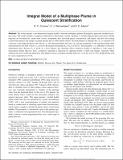Integral Model of a Multiphase Plume in Quiescent Stratification
Author(s)
Crounse, B. C.; Wannamaker, E. J.; Adams, E. Eric
DownloadCrounse-2007-Integral Model of a Multiphase Plume in Quiescent Stratification.pdf (165.6Kb)
MIT_AMENDMENT
MIT Amendment
Article is made available in accordance with the publisher's policy and may be subject to US copyright law. Please refer to the publisher's site for terms of use.
Terms of use
Metadata
Show full item recordAbstract
The writers present a one-dimensional integral model to describe multiphase plumes discharged to quiescent stratified receiving waters. The model includes an empirical submodel for detrainment, and the capability to include dispersed phase dissolution. Model equations are formulated by conservation of mass, momentum, heat, dissolved species concentration, and salinity, and allow the tracking of dissolved material and changes in plume density due to solute density effects. The detrainment (or peeling) flux, E[subscript p], is assumed to be a function of the dispersed phase slip velocity, u[subscript b], the integrated plume buoyancy, B[subscript i], and the momentum of the entrained plume fluid, characterized by the fluid velocity, u[subscript i], given by the general relationship E[subscript p]= ε(u[subscript b]/u[subscript i])[superscript 2](B[subscript i]/u[subscript i][superscript 2]). The parameter ε is calibrated to laboratory experimental data. Because E[subscript p] is based on a force balance, this algorithm allows numerical models to reproduce a wide range of characteristic plume behavior. Such a predictive algorithm is important for applying models to field scale plumes, especially where chemical processes within the plume may alter plume buoyancy (and hence peeling behavior), as in the case of a CO[subscript 2] droplet plume used for ocean sequestration of CO[subscript 2].
Date issued
2007-01Department
Massachusetts Institute of Technology. Department of Civil and Environmental EngineeringJournal
Journal of Hydraulic Engineering
Publisher
American Society of Civil Engineers (ASCE)
Citation
Crounse, B. C., E. J. Wannamaker, and E. E. Adams. “Integral Model of a Multiphase Plume in Quiescent Stratification.” Journal of Hydraulic Engineering 133.1 (2007): 70. Web. 20 Apr. 2012. © 2007 ASCE
Version: Final published version
ISSN
0733-9429
1943-7900